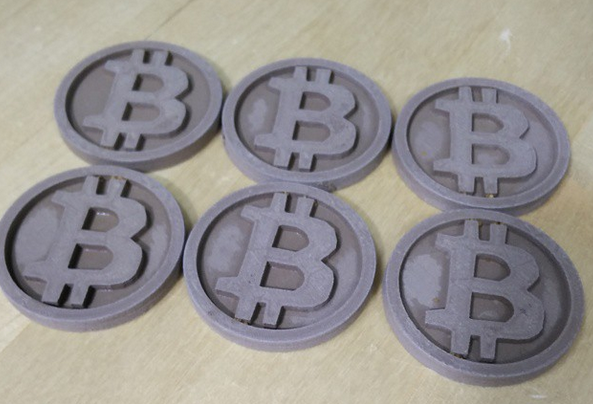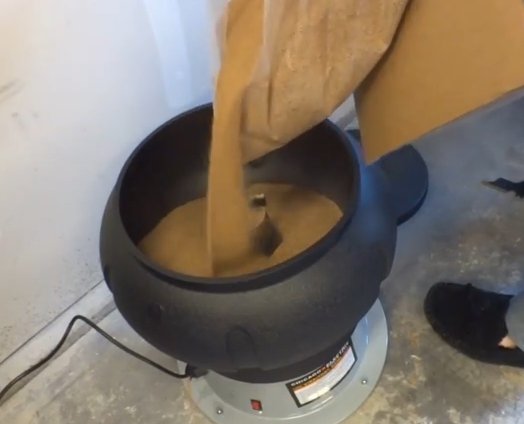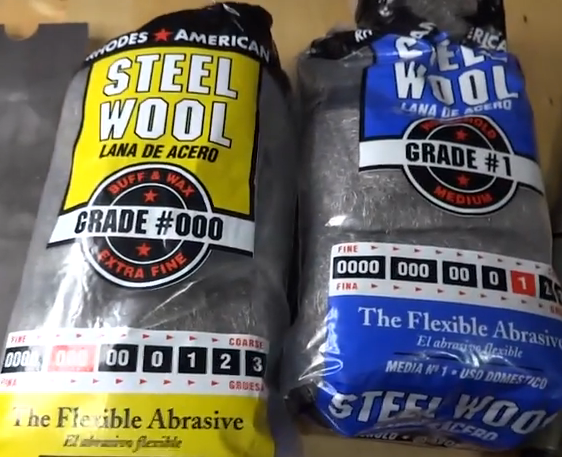Barnacules Tests the Various Polishing Methods of colorFabb’s bronzefill by 3D Printing Metal ‘Bitcoins’
Time and time again, we have stressed how important the materials sub-market is to the entire 3D printing industry as a whole. The ability to print with a variety of materials will ultimately be what pushes this incredible technology to new frontiers. It’s really quite amazing what a small change within the composition of a thermoplastic-like PLA or ABS can do to a finished print.
You have probably all heard of colorFabb by now, the Netherlands-based company which has concocted an incredible assortment of very unique thermoplastic filaments for FDM and FFF 3D printers. One of their more popular filaments is called bronzeFill. Composed of 20% PLA and 80% actual bronze powder, bronzeFill is incredibly dense and can be used to fabricate objects which look and feel very similar to that of an actual bronze object.
It order to show just how incredible bronzeFill printed objects can turn out, as well as the best way to polish them to a shine, we have teamed up with Jerry Berg, known as Barnacules on his hit Youtube channel ‘Barnacules Nerdgasm‘, to 3D print and polish a few objects.
Barnacules, like myself, also has an infatuation with the online cryptocurrency known as Bitcoin. He, like many others, also believes that one can never have enough Bitcoins, as  the currency hovers around $350 per coin. When mining them doesn’t suit your fancy, then why not do the next best thing? 3D print them! Although it may be difficult to sell off these 3D printed Bitcoins for anything close to the actual market value of a ‘real’ Bitcoin, Barnacules felt that at least he, as well as his fans, would learn something from the process.
the currency hovers around $350 per coin. When mining them doesn’t suit your fancy, then why not do the next best thing? 3D print them! Although it may be difficult to sell off these 3D printed Bitcoins for anything close to the actual market value of a ‘real’ Bitcoin, Barnacules felt that at least he, as well as his fans, would learn something from the process.
To start, he set his Ultimaker 2 3D printer to an extrusion temperature of 220C, while heating the bed to 60C. He set his print speed at 50mm/sec and began the printing process. As it makes its way out of the extruder, the bronzeFill appears similar to a muddy clay, or perhaps easier to picture, a fully tarnished penny from the mid 1980’s. Once printed it was now time to experiment with various methods of polishing the coins, with the end goal being a ‘Bitcoin’ which has the shine of a brand new penny. Let’s check out the results:
Vibratory Bowl
Using a brand new machine from Chicago Electric, Barnacules filled it with walnut shell media, as this was recommended online for shining objects such as bronze. The ‘Bitcoins’ were placed in the bowl with the walnut shells for two hours prior to being removed. At this point, there was little to no change, besides some minor smoothing of the coins, as well as a slight lightening of their color. Next, Barnacules decided to add a handful of polishing abrasive into the bowl, and then run the machine for another couple of hours. When removed, the coins still showed barely any change and certainly no shine. Next, a couple cap-fulls of Nu Polish (yes, the car wax we are all familiar with) was added into the polisher. After a total of 14 hours, the coins emerged still relatively unchanged.
as bronze. The ‘Bitcoins’ were placed in the bowl with the walnut shells for two hours prior to being removed. At this point, there was little to no change, besides some minor smoothing of the coins, as well as a slight lightening of their color. Next, Barnacules decided to add a handful of polishing abrasive into the bowl, and then run the machine for another couple of hours. When removed, the coins still showed barely any change and certainly no shine. Next, a couple cap-fulls of Nu Polish (yes, the car wax we are all familiar with) was added into the polisher. After a total of 14 hours, the coins emerged still relatively unchanged.
Dremel Rotary Tool with Wire Brush
Not discouraged by the 14 hours of vibratory polishing, Barnacules next turned his attention to a Dremel rotary tool, equipped with a wire brush. Immediately he found that the heat build-up from the friction of the tool caused the thermoplastic based material to begin melting. A very quick motion was needed in order to prevent too much heat from being concentrated into one area. After spending a decent amount of time using the tool, the outcome was a somewhat shiny, although inconsistent finish to the coin. Also some minor warping appeared to occur from the possible melting of the material.
Sandpaper 150 & 400 Grit
Sandpaper was the next polishing tool to be used. The 150 grit paper didn’t do much. Perhaps a very minor shine came through, but overall there was little change. The 400 grit paper, however, actually worked quite well, leaving a shine which did in fact make the coins glisten a bit.
Steel Wool after using 400 Grit Sand Paper
Barnacules used steel wool by itself and found that he got some pretty decent results. However, he wondered what would happen if he used the 400 grit sandpaper first, and then the steel wool. This ended up being the best solution to achieving a shine with the bronzeFill, leaving the coins glistening, looking quite incredible. To finish things off even more, a touch of Brasso liquid polish was added to the mix, resulting in a shine that’s sure to catch the eye of even those who don’t know what a Bitcoin is.
a shine with the bronzeFill, leaving the coins glistening, looking quite incredible. To finish things off even more, a touch of Brasso liquid polish was added to the mix, resulting in a shine that’s sure to catch the eye of even those who don’t know what a Bitcoin is.
While the experiment started out leaving us all wondering if this filament really could be polished with ease, we”ve learned that the best way to polish bronzeFill is also the cheapest and easiest way; sandpaper, and steel wool. Barnacules intends to try other forms of media within his Vibratory bowl to see if perhaps they can provide a better result. Until then, if you wish to shine up a Bitcoin, a bronze statue of yourself, or even a partially metal 3D printed iPhone case, all you have to do is run out to the hardware store and pick up the materials for a few bucks. Let us know if you have tried polishing any bronzeFill printed items yourself. Discuss in the Polishing bronzeFill forum thread on 3DPB.com.
Subscribe to Our Email Newsletter
Stay up-to-date on all the latest news from the 3D printing industry and receive information and offers from third party vendors.
You May Also Like
Precision at the Microscale: UK Researchers Advance Medical Devices with BMF’s 3D Printing Tech
University of Nottingham researchers are using Boston Micro Fabrication‘s (BMF) 3D printing technology to develop medical devices that improve compatibility with human tissue. Funded by a UK grant, this project...
3D Printing Webinar and Event Roundup: April 21, 2024
It’s another busy week of webinars and events, starting with Hannover Messe in Germany and continuing with Metalcasting Congress, Chinaplas, TechBlick’s Innovation Festival, and more. Stratasys continues its advanced training...
3D Printing Webinar and Event Roundup: March 17, 2024
It’s another busy week of webinars and events, including SALMED 2024 and AM Forum in Berlin. Stratasys continues its in-person training and is offering two webinars, ASTM is holding a...
3D Printed Micro Antenna is 15% Smaller and 6X Lighter
Horizon Microtechnologies has achieved success in creating a high-frequency D-Band horn antenna through micro 3D printing. However, this achievement did not rely solely on 3D printing; it involved a combination...






























